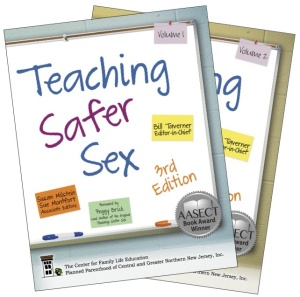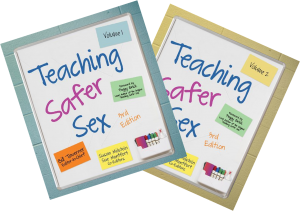Someone recently mentioned an activity in Teaching Safer Sex to me that I hadn’t even heard of! Which means, clearly, I haven’t written about enough lessons from this awesome two-volume manual yet. So I’m going to dive deep this week, and maybe next, and maybe even the one after that if I get on a roll!
I want to start with two pages of the four-page foreword to Teaching Safer Sex, written by the illustrious Peggy Brick. The introduction to this manual begins with a general history of the Center for Sex Education (formerly the Center for Family Life Education), and then moves into a history of this particular manual, which is now in its third edition.
Welcoming a 50-Lesson Teaching Safer Sex!
Teaching Safer Sex may be the most important contribution the CFLE has made to the pedagogy of sexuality education. It was 1988 when most HIV/AIDS education was about epidemiology and the function of T-cells that the CFLE created its groundbreaking first edition of Teaching Safer Sex. Ten years later, many of the innovative strategies from that manual were classics in the field and had been incorporated into hundreds of curricula that aimed to develop the motivation, knowledge, comfort and skills essential for safer sex behaviors. It was time for a second edition, and The NEW Teaching Safer Sex aimed to expand the scope of safer sex education to include the social context of people’s sexual behavior. Paulo Freire’s ideas put forward in The Pedagogy of the Oppressed were important in the development of the new manual, which recognized that in a society so dangerously ambivalent about teaching its young people about their sexual safety, they needed to learn about the powerful societal, as well as personal, barriers to healthy sexual behavior. Twenty lessons were designed to promote critical consciousness about social messages as well to create a climate where communication about sexuality is normal and the use of safer sex is the expected behavior.
Now, almost 15 years later, it takes 50 lessons in two volumes to address the complex and changing world of sexual safety. The third edition of Teaching Safer Sex is awesome and it is a challenge! It requires educators to think seriously about the real needs of the people they teach and to decide which of this plethora of lessons will best help their students live a safe sexual life. In addition to now-classic lessons from the earlier editions, the third edition is greatly enhanced by lessons created by more than twenty educators with experiences from across the nation. Imaginative new lessons by the CFLE’s unique team of educators expand the definition of sexual safety and address new technologies, relationships and other issues that have profoundly altered the sexual milieu. They have produced a truly comprehensive approach to safer sex education.
The comprehensive introductory section undergirds the entire manual by establishing “Principles for Sex Education,” “Goals and Objectives for Safer Sex Education” and the process for “Creating a Supportive Environment.” Dedicated attention to these basics is essential for the success of every lesson. And, by wisely putting “How to Use Role-Play” up front, the editors have recognized the vital importance of role-play. Rehearsal of difficult, real-life situations that are identified by the students themselves may be the most powerful way to develop the insights and skills needed for safer sex. Every sexuality educator will be rewarded by developing the ability to facilitate role-play effectively.
Two new lessons, “Defining Sexual Health” and “Sexual Health in Prime Time” provide a solid foundation for other lessons. Other new lessons reveal the radical changes in the sexual environment of youth today by examining the technological world relevant to their lives. I wonder how educators can choose! Will their students learn about “Practicing Safe Text,” “Sex, Sex, Everywhere!: Sexually Explicit Media and Teens,” or “Safer Cyber Sex: Exploring Online Relationships”? Lucky are the students who experience all three!
New lessons such as “How Could That Be?: A Lesson About Identity, Behavior, Perception and Risk” reflect our growing awareness of the particular risks faced by lesbian, gay and bisexual youth. “Inclusive Safer Sex” goes further by focusing on various sex acts rather than the identities of people performing them and provides lesbian, gay, bisexual, trans, queer and intersex people with specific affirming examples. How fortunate the editors were able to engage the expertise of educators with such profound understanding of the unique educational needs of these populations.
New, too, is the inclusion of a lesson on “Teaching Condom Use to an Audience with Special Needs” which targets moderate- to high-functioning individuals with intellectual and developmental disabilities. By validating their right to safer sex information, Teaching Safer Sex affirms people whose sexuality is often discounted or ignored.
The felicitous expansion of Teaching Safer Sex has required it to address a number of controversial topics. Educators must choose lessons wisely in order to provide as much education as possible, while remembering that not every lesson is appropriate for every audience. Remember, most important is to develop students’ critical consciousness and help them feel in control of their sexual lives, even if you are unable to use some of the most innovative lessons in Teaching Safer Sex.
So, what’s controversial? To start with, “Masturbation: A Safe, but Touchy Subject” — a most important lesson validating a common behavior that leaves many people feeling guilty — but advocating it got a U.S. Surgeon General fired. “Sensually Sexy Safer Sex” promoting the pleasurable aspects of condoms is another. Advocating pleasure? Many people prefer a fear-based approach to sexuality education as brilliantly examined in “Be Afraid! Be Very Afraid!: Examining Fear-Based Methods in STI Prevention.” “Rethinking Withdrawal” will also raise controversy by challenging the absolute denunciation of “pulling out.” Like many Teaching Safer Sex lessons, it provides accurate information and respects young people’s ability to understand that sexual decisions are complex and require thoughtful decision-making.
“Oral Sex and Abstinence” is one of my favorite lessons because it provides participants an opportunity to clarify their beliefs not only about oral sex but about the meaning of intimacy. It will provoke important discussions. Finally, “Securing the Back Door: A Guide to Safer Anal Sex” reveals the determination of these editors to include a lesson needed by some educators if they are to truly meet the safety needs of their students. I commend them.
But surely the most famous of these fifty lessons is the joyous “’You’re Out, Baseball!’ A Healthier, More Equitable and Safer Model for Sexuality Activity” by Al Vernacchio, who was featured in the New York Times Magazine cover story, “Teaching Good Sex” on November 20, 2011. Vernacchio builds on concepts introduced by Deborah Roffman to challenge the popular “baseball” model of sexual behavior and thus exemplifies how the lessons of Teaching Safer Sex aim to help young people be critical of pervasive social attitudes that undermine their potential for sexual health.
Twenty-three years ago the original Teaching Safer Sex revolutionized the way educators teach about safer sex in the time of HIV/AIDS. Bill Taverner, Susan Milstein and Sue Montfort continue the tradition by creating a manual that responds to the present needs of varied educators, serving varied populations, with varied risks. Congratulations to the editors, to Triste Brooks, president and CEO of this Planned Parenthood affiliate, for her crucial support, and to the remarkable board of directors. Their EASE (Ensuring Access to Sex Education) endowment fund has demonstrated the organization’s solid support for the CFLE’s vital national leadership in sexuality education.
While the full foreword can be read on Teaching Safer Sex’s webpage, it is this portion that I think most aptly presents what is exciting, innovative, and ultimately useful about the manual. When an experienced educator like Peggy Brick gets excited about new lesson plans, you know you’re in for something special!
I’ve already written about seventeen of the lessons in this two-volume manual, but I still have thirty-three to go! You can read all of the posts I’ve written about lessons from Teaching Safer Sex (plus other posts about things like Teaching Safer Sex winning the AASECT book of the year award!) here: http://www.sexedcenter.org/category/teaching-safer-sex/
And keep coming back! I’m going to be giving this manual lots more love in the coming weeks!





